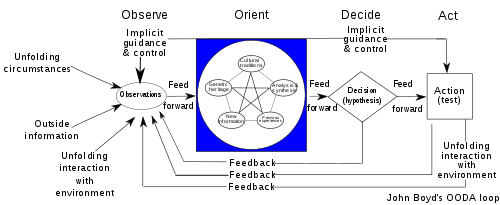
- Language originates as social behavior (Wittgenstein, Dennett).
- Signals coordinate actions among groups engaged in gathering or hunting.
- The inner voice comes later, when an individual realizes that by misinforming others with their vocal behavior, they can enlarge there share of benefits. For example, by withholding or delaying informing others when one finds an especially rich patch of berries.
- Mind is an organization or activity supported by the brain organ, not a separate material or channel for forging pathways between ideas; incoming sense-data and outgoing volitions are routed along similar neural pathways (Ryle).
- Both ideas and volitions propagate as connections between neurons (encoding beliefs into ganglia connections as programmers encode rules into 0’s and 1’s).
- A volition can be stored as a remembered response to an idea inferred from sense-data; a voltional response to a stimulus is as much a generalization as is the classification of a stimulus by categories. Neural coding can retain and connect ideas with volitions, as well as ideas with ideas and volitions with volitions.
- Connections that are repeated, or positively reinforced, strengthen or multiply.
- Social groups discover sets of rules which allow them to coordinate better. Such sets of rules proliferate within that group because the group works better using them, and thus reinforces them either by rewards and sanctions or simply by producing more to be shared among its members.
- Vocabulary, grammar, and syntax are among the sets of rules necessary to make vocal communication possible and then optimal.
- Other sets of rules that amplify the powers of the group are such things as arithmetic and codes of behavior, and generally, the arts and sciences, from the very first crafts and lore (arrowhead chipping, woodlore, folk medicine) to modernity’s established technologies, industries, and academic disciplines.
- Most sets of rules that emerge within groups are happenstance; they are peculiar to that group, and in that sense arbitrary and accidental. In other words, these are cultural quirks, local conventions, or, as is customary now to call them, social constructs. They are tribal habits of practice and speech covering everything from daily practices to belief systems to codes of accepted behavior.
- Some sets of rules, however, have internal schematic restrictions, restrictions which apply to anyone anywhere working within that defined schema. Arithmetic was probably the first of these. Logic was another, later, addition.

- Philosophy strives to create more of these, usually with at most partial or temporary success. This is not because philosophy is a futile endeavor (as the logical positivists would have it), but because, in trying to explain whole disciplines of thought, philosophy must encompass more than a single, self-defining schema. The exceptions to this rule are those disciplines which can be captured by (reduced to) a single self-defined schema.
- Mathematics, the first discipline to be so captured, is structured by the schema of an axiomatized formal system, in which beginning from as few and as indisputable axioms as possible, one can construct a system of interlocking theorems using pure logical deduction, following known rules of inference.
- Logic, by this light, seems to be built around the schema of set theory, as illustrated in Venn diagrams.
- The scientific method is another, later, extraordinarily productive schema, which imposes rigid, standardized rules of procedure and inference on all who would operate under its authority.
- Computer science is that branch of mathematics which operates under the schema of an algorithm, an entirely rules-based system for specifying the steps in an operational sequence, ideal for the practical purpose of running computer programs that can both organize information and run operations.
- The social contract is, arguably, a schema which can work similarly in coordinating the interactions of agents, that is, a system of politics and ethics.
- Any such schema (i.e., self-defining set of rules) — whether chess, the scientific method, or the social contract — rearranges neural pathways along the following lines:
- Anyone wishing to participate in the group following this schema — whether to play chess, to do science, or to live under the protection of rights – must follow the schema to be recognized as “playing fair,” and allowed the benefits of playing (and perhaps winning) a game of chess, doing science (and perhaps being credited with a break-through), or having their rights respected and not being punished for violating the rights of others.
- In short, the social consequences of following or not following the rules work the same way on the neurological system that trial-and-error experience works on learning in daily life.
- And while all kinds of quirky and arbitrary social customs propagate themselves in this way, self-defined schema have a universal and mandatory form for anyone wanting to work within the groups organized around such schema.
- Donald Trump is a bad haircut.
- It’ll grow out, just give it time.
- Please don’t judge me by how I look now.
- Still, we won’t be stepping out together for a little bit.
- While I get over this.
- Observe-Orient-Decide-Act.
- Describes the decision cycle of any rapid-response interaction with constantly changing circumstances and incoming information.
- Originally developed for the combat operations of fighter pilots by Colonel John Boyd of the U.S. Air Force, it is now often applied to business operations and learning processes.
- The steps:
- Observe: gather available information
- Orient: focus in on the critical aspects of the situation
- Decide: choose your next move
- Act: execute your chosen move
- As you and your opponent’s moves begin to alter the situation, repeat the OODA loop.
- Link to article in Wikipedia: https://en.wikipedia.org/wiki/OODA_loop
- OODA Loop applied to the learning process goes by the names learning cycle or double-loop learning.
- I first learned about the OODA loop in Lawrence Freedman’s Strategy: A History.

Thinking German, Talking Irish, on Big Questions, with Banter



